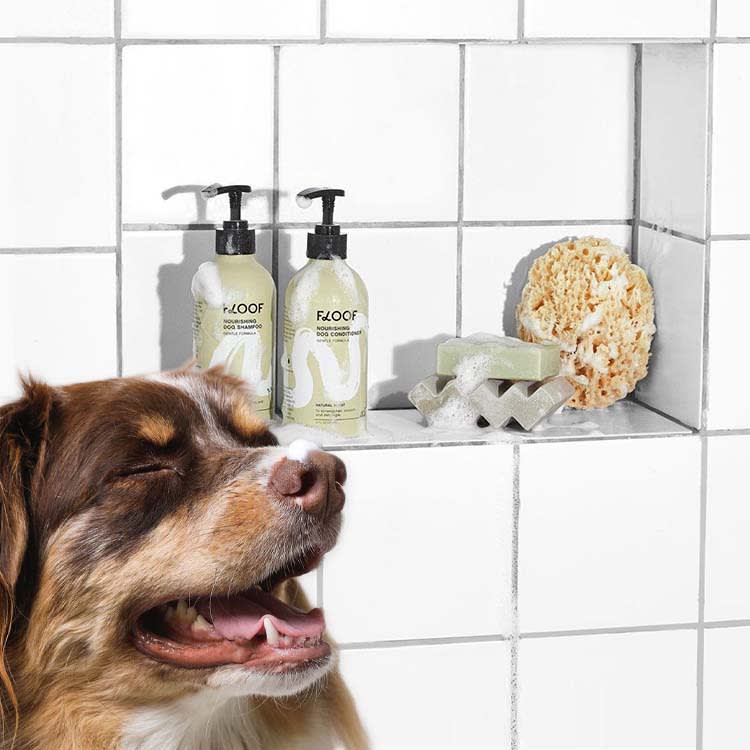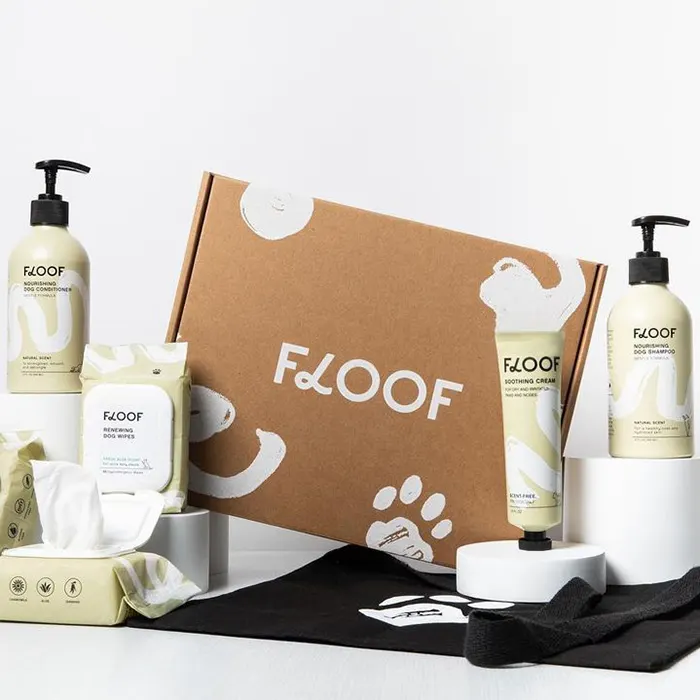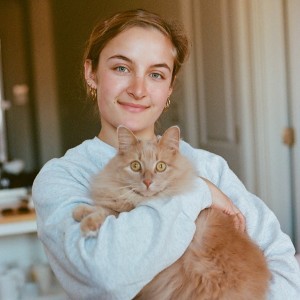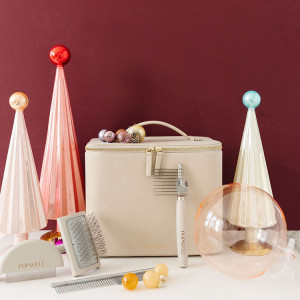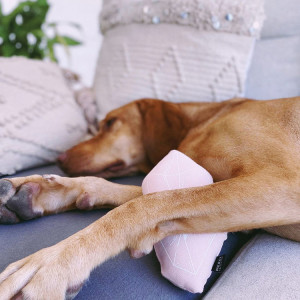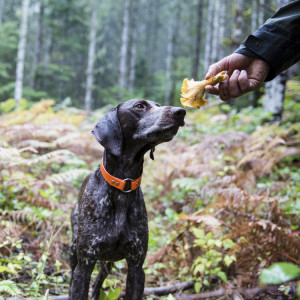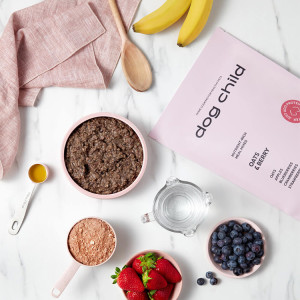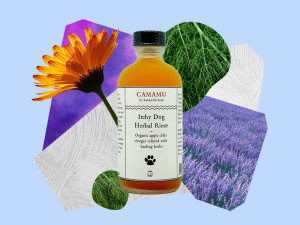Floof Takes a Gentle Approach to Your Itchy Dog’s Skincare
Mark your pups’ self-care calendars: The company’s eco-friendly, allergy-friendly products are launching July 17.
As with almost every pet brand, Floofopens in new tab, which is officially launching July 17, was an invention of necessity. The grooming product company’s founder, Michael Kim, was dealing with the day-to-day obstacles of grooming his French Bulldog, Leo. Multiple trips to the veterinarian later, Kim was still unable to find a shampoo or conditioner gentle enough for Leo’s sensitive and allergy-prone skin. He elected to do some research on his own to find the right fit.
“Personally, I had seen a lot of benefits from using high-quality, premium, clean skincare for my skin issues, and I was looking for the same quality of products for Leo after visiting the vet and couldn’t find anything,” he tells Kinship.
Trick question: All dogs are perfect! But find out which type is the best fit for you.
Having previously worked at Dr. Squatch, a mens’ personal care brand, Kim felt uniquely prepared to start his own company within wellness, self care, and grooming — but not without the help of the experts. He consulted with veterinary dermatologist Dr. Jennifer Schissler to be sure Floof’s products were the absolute best they could be. Kim shares his process for developing Floof formula, the importance of using non-irritating ingredients, and his mission to make dog grooming fun.
How did Leo’s allergies inspire you to start Floof?
It really started with Leo. I got Leo three years ago, during the pandemic. He was my first Frenchie, and I was not ready for how many skin issues he would have. Starting when he was six months old, he got really bad allergies, and eventually he started licking his paws like crazy until they got red and inflamed. I was scared, so I took him to the local vet, and they basically told me that he had a yeast infection and pretty bad skin allergies. The vet told me to use Dawn dish soap on his paws, which was absolutely shocking to me. So, I did a bunch of research online...
How much do you spend on your pet per year?
What did you discover about the quality of dog-grooming products?
Personally, I had seen a lot of benefits from using high-quality, premium, clean skincare for my skin issues, and I was looking for the same quality of products for Leo and couldn’t find anything. Through my research, I found two things: First of all, the FDA doesn’t regulate dog-grooming products that are not medicated. That means that brands can pretty much put whatever they want on the labels of their products. They don’t even have to legally list the ingredients, and a lot of the time, they package harmful chemicals into products with very vague terms like “coconut-based cleanser.” They also claim for them to be all-natural when they’re not.
How do dogs’ skincare needs differ from ours?
I also realized that dogs have three-to-five times thinner skin than we do, which means that they’re a lot more susceptible to developing irritation to harmful ingredients in chemicals. So, after learning those two things, I was like, There has to be a brand providing these products to customers and I couldn’t find any brand — at all. I tried a couple brands, the fully organic, natural ones, and those didn’t work on Leo because they didn’t have any chemicals at all, so they didn’t cleanse his skin. They were really tough for me to use because they didn’t spread across the body, they didn’t sud, they didn’t wash off, and they actually left a residue. Then, on the other side, the typical dog shampoo has all of these harsh chemicals, and they had always made his skin worse. That’s how I decided to come up with my own brand.
What was helpful about having a veterinary dermatologist on board with this process?
I reached out to Dr. Schissler because I really wanted to focus on innovation within the formulation process. I didn’t want to just come out with any formula that had already existed, so we spent a year working with skincare chemists. We’re launching with a shampoo, conditioner, paw and nose cream, and wipes.
Our shampoo is unique because it doesn’t have harsh chemicals and has a lot of ingredients that moisturize the skin. There’s that misconception that you can only wash your dog once every three months or it’s going to strip your dog of their natural oils. That’s only true when you’re using products that have those harsh chemicals and ingredients. When you’re using a gentle and moisturizing product like ours, you can wash your dog as often as you want.
We actually recommend that you wash your dog more often because it’ll cleanse them of the allergens of the chemicals that they encounter when they’re walking on the sidewalk, like salt to get rid of the snow or pesticides. Because if you’re not washing that off, it’s essentially just staying on their skin for three months, which is insane.
The line uses a lot of language like “gentle” and “soothing.” Were irritating products something you’d come up against as a pet parent?
I think the main ingredient is surfactants. Ninety-five percent of dog shampoos use harsh surfactants, mainly SLS or coco betaine. We believe that surfactants are necessary, because without them, your dog is not going to be cleansed of bacteria, dirt, and allergens. There are harmful, harsh surfactants (the ones that are typically used) and then there are more gentle, non-irritating surfactants that are typically more expensive. We removed all the harsh surfactants from all of our formulas, and we only focus on using the most gentle ones that won’t irritate a dog’s skin.
The Floof shampoo and conditioner bottles are also so pretty. What was the thinking behind the design?
Branding and design were top priorities to me from the beginning. The reason why I wanted to focus so much on that was, as a millennial and knowing a lot of other millennial [and] Gen Z dog owners, sometimes taking care of our dog’s skin and grooming them can be a pain in the ass. It’s definitely a chore. I thought about it, and my friends and I get excited when we buy a new moisturizer or get a new shampoo. It’s fun for us, but why is dog grooming so boring and why is it such a chore?
I think it’s because of how outdated the packaging and branding is for a lot of these dog grooming brands. I wanted to motivate and inspire younger dog owners to enjoy taking care of their dog’s skin so it’s fun, it’s something that you can upload on Instagram, you can have your dog’s products sit right next to yours, and have them look nice.
Why was it important for you to consult a veterinary dermatologist?
I didn’t actually know that veterinary dermatologists existed. While I was doing my research, I was like, there are cardiologists and different specialists, maybe there is a dermatologist, skin-focused doctor. I looked it up and I found out that there are less than 100 vet dermatologists in the U.S. They go through a really rigorous process of training, and so they are the experts on dog skin. Working with Dr. Schissler was so important to us throughout the entire formulation process, not only from an ingredient perspective, but just understanding, “What is the purpose of this shampoo? Why are we even creating this and how is it going to benefit dog owners?”
What were your biggest takeaways from working with Dr. Schissler?
Obviously, when a dog’s skin gets so bad, whether it’s allergies or skin infection, they’re going to need to go to the doctor and take antibiotics or allergy shots, but we really wanted to focus on the idea of preventative maintenance. A lot of dog-grooming brands try to tell the customer, “If your dog has severe allergies, use our product and they’ll be healed that day.” Speaking to Dr. Schissler taught me that that is pretty much impossible. If your dog has severe allergies, using one type of shampoo is not going to be a miracle cure. That really shaped our strategy for the formulation process. We didn’t want to create a product that was only going to be focused on allergies and skin irritation. We wanted to create a product that was for maintenance care — keeping your dog’s skin clean, moisturized, and making it gentle enough.
What were her recommendations from a medical standpoint?
For our paw and nose cream, one thing Dr. Schissler wanted was for it to be really fast drying, because there are two issues that can happen with cream. A lot of brands have Vaseline type of balms that don’t dry fast, so when a dog starts running around after you put the cream on, they can slip. That’s really bad for their joints, and they can get injured. Also, dogs love to lick anything that you put on to them. During the formulation process, we left out all ingredients that could be toxic or harmful to dogs, but we wanted it to be as fast-drying as possible, so they don’t lick it off or get sick from eating it.
What made you want to use human-grade ingredients in Floof’s formula?
I think there has been a sort of premiumization within every category in the dog space, except grooming. The food has human-grade ingredients. The same goes for supplements and accessories. But you haven’t really seen any innovation or development within the grooming and skin-health space. That means that these formulas haven’t really been updated for the last 10 to 15 years. I really wanted [Floof] to really be science-backed and use the same ingredients that skincare and haircare products are using today.
That’s where Dr. Schissler came in. There are certain ingredients that dogs can’t use that are safe for humans and those ingredients we removed. The pH balance was really important. We wanted it to be more alkaline, not as acidic as human skincare products.
Did you set out to create a sustainable product?
From the get-go, I wanted to create an eco-friendly product. As a startup [that] is self-funded without venture funding, it’s pretty tough because a lot of the time the packaging for more sustainable products is more expensive, but I still wanted to stick to it and see what options I could have. We ended up finding a really great aluminum bottle that’s recyclable, so we went with that and even though it’s a little bit more expensive, it aligns with our brand.
We will also be selling our shampoo and conditioner with the aluminum caps, so when you first buy the shampoo, you can buy it with the pump, and if you need to refill it or order more, you can remove the pump from [the bottle] and that’ll save on purchasing plastic for our pump over and over again. Our goal is to come up with exact instructions for how to recycle our products, how sustainable they are, and what impact they have.
